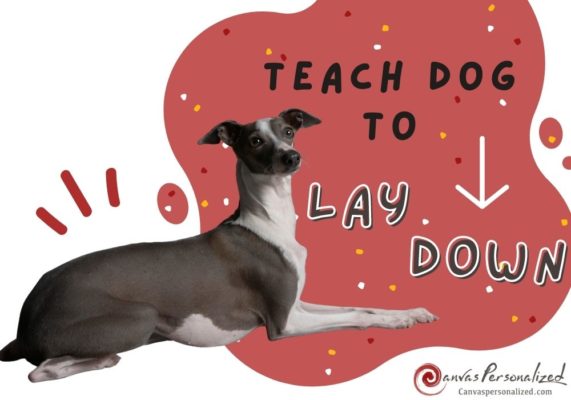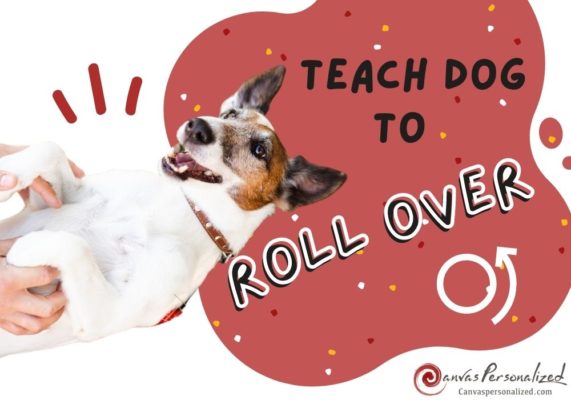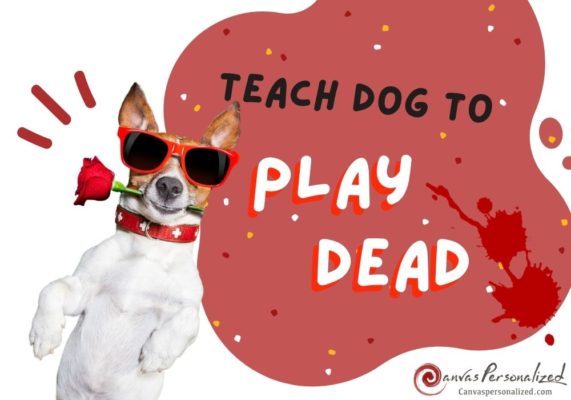Welcome to Canvas Personalized‘s complete guide to positive reinforcement dog training. If you own a dog and are looking for ways to train it that are both effective and kind, you’ve come to the right place.
Positive reinforcement is a method that has been shown to work by science. It praises and reinforces desired behaviors instead of punishing them or using aversive techniques. In this piece, we’ll discuss the ideas behind positive reinforcement training and give tips and tricks to help you train your dog using positive methods.
What Is Positive Reinforcement Dog Training?
Positive reinforcement dog training is a training method that focuses on rewarding desired behaviors in dogs instead of punishing unwanted behaviors. It’s founded on the idea that when a dog does something its owner approves of, it should be rewarded with something pleasant like food, attention, or play. When a reward follows a positive action, the two become inseparable.
To teach a dog to sit, for instance, you might ask it to sit and reward it with a treat. The dog’s likelihood of complying with future sit requests will increase because the behavior was rewarded.

Basic obedience commands, behavioral difficulties, and owner-dog communication and comprehension can all benefit from positive reinforcement training. With this method, the dog and the owner can have fun while learning together, which will develop their relationship and trust between them.
What Is the Difference Between Positive and Negative Reinforcement?
Contrary to popular belief, “negative reinforcement” does not refer to the opposite of positive reinforcement. Both positive and negative can be useful in dog training tips because they increase the likelihood that a behavior will be repeated.
Positive reinforcement techniques might enhance the frequency of a desired behavior in the future, such as rewarding the dog with a treat when it sits when told to.
Negative reinforcement involves removing an unpleasant stimulus after behavior to increase or repeat the chance of desirable behavior.
Positive punishment involves adding an unpleasant stimulus after a bad behavior to decrease the likelihood of that behavior being repeated.
Negative punishment involves removing a desirable stimulus after a behavior to decrease the likelihood of that behavior being repeated.

In conclusion, the goal of positive reinforcement in dog training is to increase the frequency of the desired behavior by providing incentives, while the goal of negative reinforcement is to decrease the frequency of the undesirable behavior by eliminating the aversive stimuli. Positive reinforcement is more compassionate and results in a more rewarding pet training experience, but both strategies can be successful.
Benefits of Positive Reinforcement In Dog Training
- Builds a strong bond
- Encourages desired behaviors
- Increases confidence: Providing your dog with effective communication and rewarding experiences is a surefire way to increase the latter’s self-assurance
- Creates a positive learning environment: dogs will have a better time during training and are more engaged and enthusiastic about learning.
- Reduces fear and anxiety
- Long-lasting results
- Effective for all dogs of many ages, breeds, and environments.
Types Of Rewards

Some types of rewards for positive reinforcement in dog training are:
- Treats: Dogs of all breeds and sizes benefit greatly from using food treats in positive reinforcement training. Pick tasty, tiny treats that aren’t too hard for your dog to chew on.
- Verbal praise: Dogs thrive off their owners’ praise by using an upbeat tone to show their approval of the desired actions.
- Toys: You can play games with your dog like fetch, tug-of-war, and hide-and-seek, or give your dog a toy to chew on or squeak.
- Petting and affection: Most dogs love petting, rubbing their bellies, or getting a massage.
- Clicker: It serves as a marker for good conduct and indicates that the dog will soon receive a reward.
- Life rewards: You can take your dog for walks, play with other dogs, and receive human attention.
- Environmental rewards: Allow your dog to engage in natural behaviors such as exploring new areas, sniffing around, or playing.
- Life experiences: Your dog can be rewarded for good conduct with trips in the car, visits to interesting locations, and introductions to other dogs and humans.
Getting Started With Dog Positive Reinforcement Training

Positive reinforcement training for dogs entails the following initial steps:
Choose the right rewards: Identify what motivates your dog the most. They can be tasty sweets, fun toys, verbal praise, or time spent playing with your dog. Use highly desirable treats to keep your dog interested and motivated during training.
Setting clear training goals: Consider the good manners and useful skills you’d like your dog to learn. Gradually shape the behavior and increase the difficulties until they understand on command.
Reward your dog immediately: When your dog performs the desired behavior, reward them immediately or use a marker (a clicker, a verbal word, etc.) to let them know that a reward is coming.
Reward your dog consistently: Rewarding your dog frequently to display the desired behavior is essential in dog positive reinforcement training.
Reward your dog intermittently: Once your dog can perform well, you can reward them less frequently and randomly. This will prevent your dog from getting too reliant on the treat and make them work harder for the reward.
Start with simple behaviors: you can use positive reinforcement in dog training to teach dogs to sit, stay, come, and go potty.
Consult an expert or vet: If you have problems or questions about positive reinforcement training for dogs, they can assist you in figuring out solutions.
Techniques For Positive Reinforcement Training

Clicker training: The click bridges the behavior and the reward and helps your dog understand what it did right.
Luring and shaping behaviors: Luring utilizes an incentive, such as a reward or a goal, to coax the dog into doing an action. It is necessary to reward intermediate stages along the way to shape behavior. This method simplifies difficult behaviors for the dog to learn by dividing them into smaller chunks.
Capturing and reinforcing good behaviors: Capturing and reinforcing are techniques of using rewards to encourage your dog to repeat the behaviors that you like. Capturing involves noticing when your dog performs the desired behavior and rewarding them for it.
Using verbal praise and physical affection effectively: Praise, even something as simple as “good boy or girl,” combined with food or other prizes, can go a long way toward encouraging desirable conduct. Gentle petting or a belly rub are two examples of physical affection that can be utilized as a reward or reinforcement.
Remember that every dog is an individual; some training methods may be more successful with specific dog breeds. To train your dog effectively, you must thoroughly understand the dog’s preferences, needs, and abilities. The best way to help your dog learn and grow is to be consistent and patient and provide positive reinforcement in dog training.
Tips To Use Positive Reinforcement In Dog Training
Choose the right rewards: Determine whether your dog responds better to rewards such as food, attention, playthings, or other dogs. Rewards should be increased for difficult actions and decreased for easy ones.
Timing is crucial: When your dog displays the desired behavior, reward it immediately. This makes it easier for dogs to associate their behavior with the desired outcome.
Be consistent: Continuously use positive reinforcement dog training. The best way to teach your dog to behave is to reward it every time.
Start small and progress gradually: Your dog will learn faster and retain more information if you start with easy instructions and routines and progressively raise the challenge as he masters them.
Use positive verbal cues: Saying “sit” or “stay” with rewards will help your dog associate the command with the desired behavior.
Avoid punishment or aversive techniques: Punitive or unpleasant methods should be avoided. Never hit or yell at your dog; it will only teach him to fear you.
Use consistency and repetition: It will create better cement lessons and instill healthy dog routines. Regular practice will aid your dog’s retention of the training and advancement of their abilities.
Make training fun: Provide your dog with play and interactive games, so you and your dog can benefit from a positive training experience.
Common Challenges In Positive Reinforcement Training

Negative reinforcement dog training frequently goes wrong because of the following:
Waiting too long to start training: It doesn’t matter how old your dog is when you bring it home; you must start teaching it immediately. This will make it less likely that your dog will develop undesirable habits and more likely to learn new things.
Insufficient training: Developing one’s skills is not a one-and-done deal. At least twice or three times a week, you should train your dog on new skills and then reinforce the good habits to keep your dog stimulated and interested.
Taking a one-size-fits-all approach: Dogs vary greatly in personalities, tastes, and propensities for picking up new skills. So you must adapt your training methods to suit your dog’s personality and skill level. Try new things and make adjustments to your training regimen as you go.
Inconsistency: Consistency in cues, rewards, and ground rules for your dog is essential for positive reinforcement in dog training. Being inconsistent throughout training will only confuse your dog and slow progress.
Using aversive methods: Use pain, fear, or intimidation to train your dog, such as a shock collar, prong collar, choke chain, leash corrections, or yelling that are brutal, useless, and potentially harmful. Instead of punishing your dog, you should use dog positive reinforcement training whenever your dog displays desirable behavior.
Using praise only: While praise effectively communicates with and shows affection for your dog, it should not be used as the sole training method. They require an incentive, like food, playthings, or games, to want to help you out.
Expecting too much too soon is impatience on your part. Training a dog takes time, and your dog won’t be able to master everything in one sitting. You and your dog should work together to achieve attainable objectives. Don’t stress your dog out by comparing them to others or expecting too much of them.
>>>Further Reading:
- How To Teach A Dog To Shake Hands Quickly With 6 Easy Steps
- How To Teach A Dog To Play Dead On Command In 5 Easy Steps
- How To Quickly Teach A Dog To Roll Over On command In 3 Easy Parts?
- How To Teach A Dog To Smile: Easy Tricks In 6 Steps
Positive reinforcement dog training focuses on rewarding the behaviors you want to see more of in your dog. You can build a strong relationship with your dog based on trust and respect by using rewards, praise, and other forms of positive reinforcement. Take reference to these positive methods from Canvas Personalized to train your dog and enjoy making him a well-mannered and happy friend.










